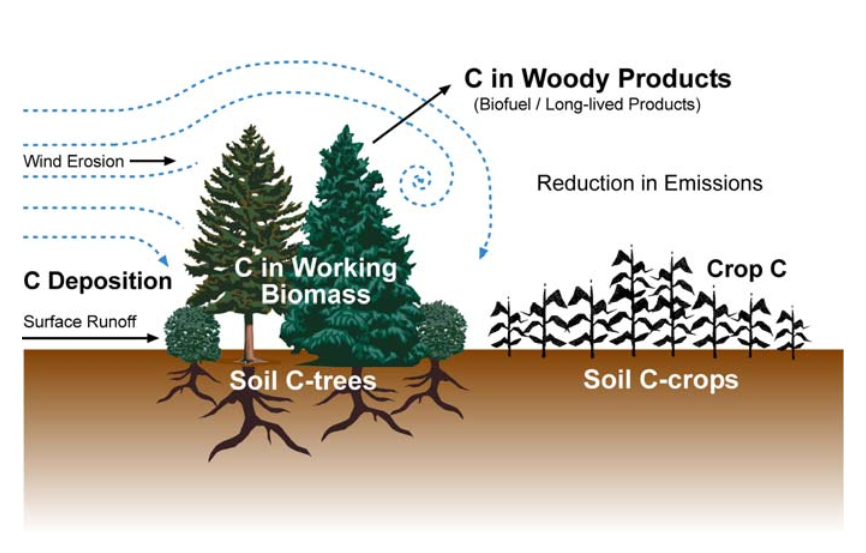The Environmental Benefits of Agroforestry
Featured image: Tannenbaum Design Group
Imagine a world where lush forests and productive farms coexist harmoniously, each enhancing the other's growth and resilience. This vision is becoming a reality through agroforestry, a land management system that integrates trees with crops or livestock. It is also emerging as a potent climate mitigation tool for enhancing carbon sequestration. The carbon sequestration potential of agroforestry rivals or even exceeds that of traditional afforestation or forest ecosystems, according to recent studies. All of this means agroforestry is gaining renewed attention, but for it to be more widely adopted, we must better understand how it works, and the environmental benefits it brings.
Understanding Agroforestry Systems
Agroforestry systems have been considered “the world’s most climate and wildlife friendly style of agriculture”, and they share one common feature: trees that are intentionally planted and maintained within agricultural areas (which refer to land designated for farming activities, including growing crops and raising livestock). Agroforestry has been practised by indigenous people around the world for thousands of years, but the term was coined in the 1970s, and its most recognizable examples include shade-grown coffee and chocolate.
Agroforestry systems (AFS) are deliberately integrated land management systems that combine trees with crops or livestock within a single management unit. When properly designed and managed, agroforestry systems are sustainable, productive, and resilient, offering economic, social, and environmental benefits. The aim is for the trees to contribute to enriching the soil, increasing crop yields, protecting crops and animals from extreme weather, diversifying farmers' incomes, and supporting biodiversity. “By planting trees you start to create the microclimate that will allow all sorts of wild organisms to inhabit the soil, and the above-ground habitats, and so to start to create a more functional ecosystem within the farm,” explains Roger Leakey, a leading expert and author.
There are different types of agroforestry.
Silvoarable agroforestry entails alley cropping: growing trees in a row and crops between them, as shown in the image below.
Featured image: USDA National Agroforestry Center
Silvopasture involves grazing livestock under trees, which provide shade for the animals as well as revenue from crops or timber.
Featured image: USDA National Agroforestry Center
Forest farming means growing high-value crops such as ginseng, goldenseal, mushrooms and decorative ferns under the protection of a managed tree canopy.
Featured image: USDA National Agroforestry Center
Riparian buffers is the practice of maintaining wild or planted strips of trees, shrubs and other plants along a river or stream.
Featured image: Philip Gruber
Finally, windbreaks are trees or other plants that shelter crops, animals, buildings and soil to reduce wind speed, protect crops from wind damage, and prevent soil erosion.
Featured image: Gary Wells, USDA Natural Resources Conservation Service
Other types of agroforestry systems also include hedgerows used to define boundaries, enclose fields, and provide ecological benefits like habitat for wildlife, and kitchen gardens — a small-scale, diverse planting of vegetables, herbs, fruits, and sometimes small trees and shrubs near a home.
Environmental benefits of agroforestry
There is significant optimism that agroforestry can be a key tool in fighting climate change, with the potential to remove up to 0.31 billion metric tons of carbon from the atmosphere each year. This is why it is currently gaining traction, and should become an integral part of climate smart agriculture and landscape restoration.
“We estimate that agroforestry is currently holding the equivalent of up to 20 years of emissions from deforestation (i.e. up to 34 petagrams of carbon or Pg C). This is perhaps the highest potential for carbon neutrality within the agricultural sector”, notes Peter A. Minang, Principal Scientist and leader of landscapes governance research at the World Agroforestry Centre (ICRAF).
In the EU, carbon sequestration rates range from 0.3 to 7 tonnes of carbon per hectare per year, with lower values typically associated with sparse tree populations, such as those found in hedgerows. A 30-year silvopastoral study involving ash trees indicated an average sequestration rate of 3.4 tC/ha/yr. Agroforestry generally satisfies the criteria for carbon projects, including permanence (primarily through the production of construction timber and deep soil impacts), minimal leakage (due to reductions in N2O and ammonia emissions, allowing animals to remain outdoors longer), and additionality (requiring incentives for establishment and maintenance costs).
Trees not only exchange oxygen and carbon dioxide with the atmosphere, but also regulate water flow. They transfer nutrients between soil and vegetation, fueling the nutrient and carbon cycles. A single tree can host millions of organisms, mostly microbes, but also insects, mammals, and birds. These organisms provide essential services like soil formation, nutrient recycling, and maintaining ecological balance to prevent weed, pest, and disease outbreaks. Trees also play a vital role in pollination, necessary for the reproduction of most plants, and in regulating carbon storage, which is crucial for climate control.
Trees prevent soil erosion (which is a major problem in Europe) and nutrient losses, increase biodiversity and natural pest control, and maintain a year-round living root system. This improves soil organic matter and overall soil health, making these systems highly effective for soil and water conservation. Trees also sequester more carbon than annual crops, storing it in soil organic matter and woody biomass. In addition, deep root systems improve water quality by reducing fertiliser runoff and efficiently using water and nutrients. They create more resilient agroecosystems, better suited to withstand climate change impacts like heat, drought, and pest pressures.
Featured image: Schoenberger 2008
Agroforestry maximises all of these benefits. It thrives on diversity, combining various tree species with food crops and animals to enhance the environmental, social, and economic advantages. Agroforestry also has the potential to create sustainable rural landscapes, offering endless possibilities for new businesses and industries. By managing this resource wisely, we can create environmentally healthy, economically viable, and socially empowering landscapes.
At Ideas From Europe, we aim to shift perceptions and incentivise adoption of agroforestry. Together, we can transform landscapes and contribute to a more sustainable future.







